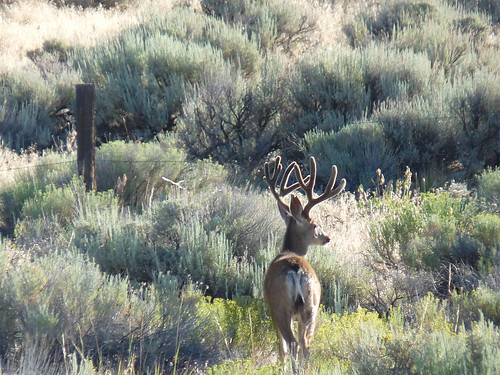
The mule deer on the Spanish Fork Ranger District, a part of the Uinta-Wasatch-Cache National Forest in Utah, are happy foragers these days thanks to a dedicated effort to improve their habitat and increase their numbers.
Mule deer are primarily browsers, with a majority of their diet comprised of broad-leaved, non-woody plants such as buckwheat and lupine and browse which includes leaves and twigs of shrubs and trees such as sagebrush and serviceberry. They are pickier eaters than larger animals like cattle and elk. Their body composition requires that they select these more nutritious plants and parts of plants than other types of feed like grass. Thus, they have more specific forage requirements and need of habitat that provides a sustainable diet, especially over the winter.
“During the past three years, our forest along with partners have thinned the pinyon-juniper landscape to allow these woody shrubs and types of vegetation to grow, thus restoring 4,000 acres of grassland and sagebrush-steppe habitat that supplies the kind of diet needed for mule deer,” said George Garcia, the district’s ranger. “Another 12,250 acres of pinyon-juniper landscape treatments are planned, which will further improve the winter range conditions for these mule deer and benefit sage grouse habitat as well.”
The success of this project is just one example of how the U.S. Forest Service and its many partners help restore the millions of acres on national forests and grasslands that are considered home for the many types of deer across North America.
The Million Bucks initiative, started in 1989, involves the agency and partners such as the Mule Deer Foundation who collaboratively work to conserve and restore habitats to support healthy deer populations that in turn will provide recreational opportunities for the public. The Mule Deer Foundation, an original partner, recently renewed their 25-year-old partnership with the agency for joint planning on projects, programs and activities that enhance the productivity of mule deer populations, associated wildlife and their habitats on national forests and grasslands.
The foundation is an active partner on the forest’s Spanish Fork Ranger District where a lot of the pinyon-juniper thinning and grooming is taking place to improve deer browse.
“Working together we can ensure a healthy population of mule deer on national forests,” said Miles Moretti, Mule Deer Foundation president. “We’re expanding our partnership efforts to increase public awareness of the importance of this icon of the West.”
The conservation efforts are necessary due to the cumulative effects of stressors on their population numbers: predators such as coyotes, mountain lions or wolves; human poaching; and loss of habitat due to highways crossing through the middle of transitional ranges, and subdivisions being built on winter ranges.
“It’s the landscape-scale conservation efforts like these that will make long-term gains in deer abundance in many areas and will improve wildlife cover and foraging conditions for a variety of species.” Garcia said.
